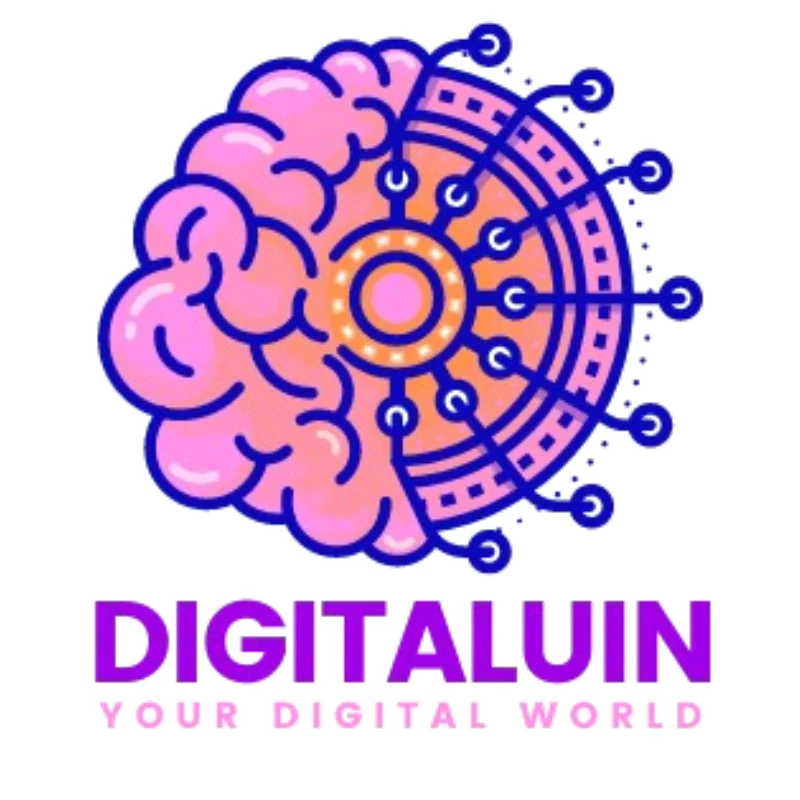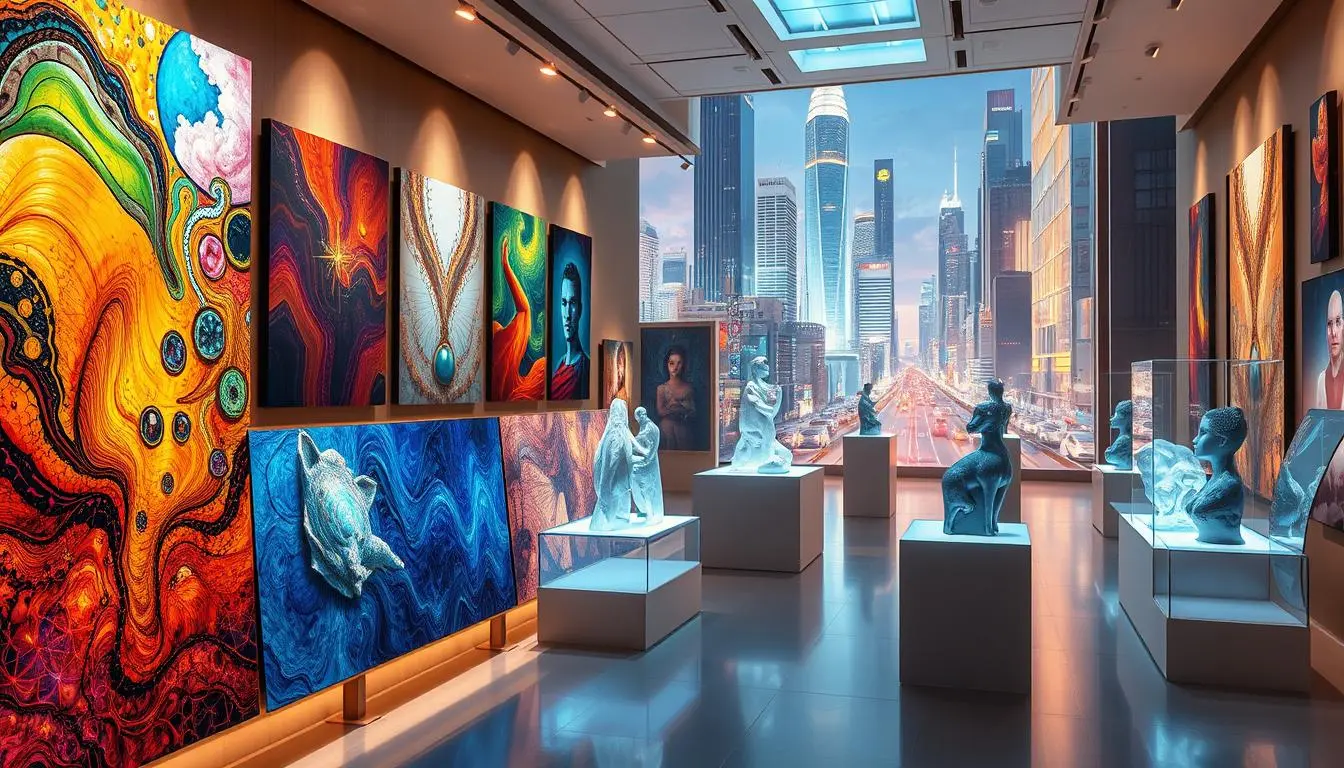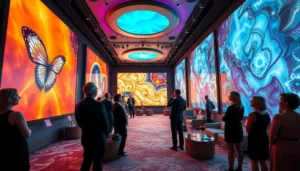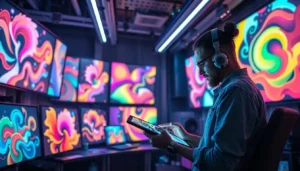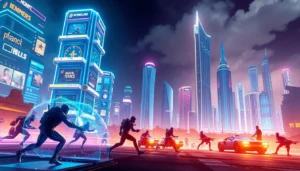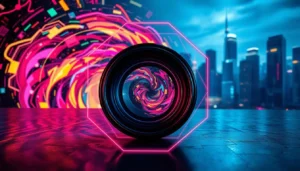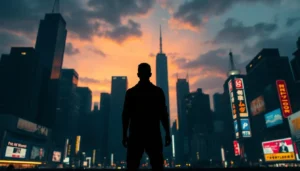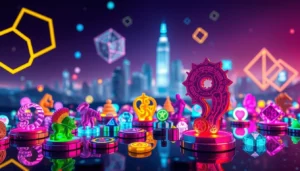NFT Art: The Future of Collecting Digital Art
You are entering a new era of digital ownership with unique digital assets. NFTs are reshaping the way digital art is perceived, owned, and collected across the world. They are stored and bought on blockchain networks, opening new paths for artists and collectors.

The rise of NFT art has been amazing over the last few years. It brings a new way for creators to make and own original works. As an investor, you can now add NFT art investment to your portfolio. This field is growing fast, blending technology and creativity.
Table of Contents
What Are NFTs and How Do They Work?
To understand NFT art, you must first know what NFTs are. Non-Fungible Tokens (NFTs) represent individual digital items with unique identifiers that distinguish them from any other asset online. They act as a digital certificate of authenticity, granting exclusive rights to unique creations such as virtual artwork.
Defining Non-Fungible Tokens
NFTs are different from other digital assets. Because each NFT has distinct characteristics, they can’t be exchanged on a one-to-one basis like traditional currency or identical assets.
The Blockchain Foundation
NFTs are based on blockchain technology. This tech makes transactions secure and transparent. It proves ownership.
Digital Scarcity and Ownership
NFTs create digital scarcity. This uniqueness is crucial when it comes to verifying ownership and authenticity in the digital landscape.
| Key Features of NFTs | Description |
|---|---|
| Uniqueness | NFTs are one-of-a-kind digital assets. |
| Blockchain Foundation | Built on secure blockchain technology. |
| Digital Scarcity | Establishes ownership and value. |
Knowing about NFTs helps you see the value and importance of NFT art.
The Evolution of NFT Art
NFT art is becoming more popular, and it’s key to know its history. This journey has seen big steps and new ideas that have changed digital art.
Early Digital Art Challenges
Digital artists had big problems, like easy copying and no way to prove they owned something. There was no strong place for buying, selling, and collecting digital art. This slowed down the digital art market.
The Birth of Crypto Art
Blockchain and cryptocurrencies brought in crypto art. Crypto art solved digital artists’ problems, making it safe and clear to create, buy, and sell digital art.
Major Milestones in NFT Art History
The digital art revolution took a groundbreaking turn in 2017 when blockchain technology birthed the first verifiable NFT collections. The true momentum behind NFT-based art began building rapidly in 2020, marking a turning point in the creative tech world. OpenSea and Rarible were key in making the NFT art market what it is today. These platforms have shaped the NFT art market.
The growth of NFT art shows how tech and innovation can change the art world. Knowing its history helps us understand and see its future.
Understanding the Technology Behind NFT Art
To fully appreciate the NFT art market, it’s key to grasp the tech that supports it. The NFT ecosystem relies on several important technologies. Multiple components come together: creation tools, blockchain technology, and digital marketplaces, to support the NFT art ecosystem.
Smart Contracts Explained
In the digital art ecosystem, smart contracts play a foundational role in how NFTs function and are exchanged. These contracts automatically enforce agreements through blockchain-encoded terms, eliminating intermediaries. This allows artists to earn royalties on their NFTs’ resale, ensuring they profit from their work beyond the first sale. Smart contracts automate the process of transferring royalties, making it transparent and efficient.
Popular Blockchain Platforms for NFTs
Most NFTs are built on blockchain platforms that support their creation and trading. Ethereum is a top choice for NFTs, thanks to its strong smart contract functionality and wide adoption. Other platforms like Flow and Tezos are also popular, as they offer different benefits such as lower transaction fees.
Minting Process
When minting, the process converts a digital creation into a token by uploading it to a compatible platform that facilitates NFT generation. Steps include setting a price, deciding on royalty rates, and confirming the transaction on the blockchain. The minting process is facilitated by smart contracts, ensuring the NFT’s uniqueness and secure ownership recording on the blockchain.
Understanding these tech aspects is vital for artists and collectors alike. As the NFT art market grows, staying updated on the tech behind it will help navigate this exciting space.

Exploring the NFT Art Marketplace
Now, you can check out many NFT art marketplaces. Each one offers special chances for artists and collectors. Today’s NFT landscape resembles a high-stakes innovation race, where emerging platforms constantly rewrite the rules of digital ownership.
Major NFT Platforms and Marketplaces
Big names in the NFT art market include OpenSea, Rarible, and SuperRare. These places let artists sell their digital art. At the same time, collectors can find and buy unique pieces.
- OpenSea: It’s a popular hub offering a broad spectrum of digital assets, including visual art, collectibles, and virtual real estate.
- Rarible: It’s a decentralized marketplace. Artists can sell NFTs here without needing to know a lot about tech.
- SuperRare: It focuses on top-notch, limited-edition digital art. It offers a special experience for collectors.
How NFT Auctions Work
NFT auctions let collectors buy unique digital art. These auctions can have a set time or go on forever. Auction dynamics fuel scarcity and demand, often pushing the perceived worth of digital collectibles higher.
Secondary Market Dynamics
The secondary market for NFTs lets collectors buy and sell NFTs after they’re first sold. This market is key for keeping things liquid and figuring out the ongoing value of NFT art.
It’s important to understand the NFT art marketplace. This includes knowing about major platforms, how auctions work, and trends in the secondary market. This knowledge helps both artists and collectors in this fast-changing field.
How to Create Your Own NFT Art
Turning your digital art into NFTs is easier than you think. With the right tools and some basic tech skills, you can become part of the NFT art community.
Required Skills and Tools
To make NFT art, you need both artistic talent and some tech knowledge. You’ll need:
- A digital art tool like Adobe Photoshop or Illustrator
- A cryptocurrency wallet (e.g., MetaMask)
- Basic knowledge of a blockchain platform like Ethereum or Binance Smart Chain
Selecting a suitable minting service is an important first step. Leading platforms include names like OpenSea, Rarible, and Mintable.
Step-by-Step Minting Guide
Here’s a quick breakdown to help you tokenize your digital artwork step-by-step:
- First, create a digital wallet compatible with cryptocurrencies and link it to the NFT platform where you intend to create and list your artwork.
- Upload your digital art to the platform.
- Add essential information about your piece, such as its name, a short description, and the price you’re asking.
- Confirm the transaction and pay any gas fees.
Pricing Strategies for Artists
Setting the right value for your NFT artwork requires balancing market trends and artistic merit. Here are some tips:
- Look at similar NFT art to see what they’re priced at.
- Think about how unique and high-quality your art is.
- Start with a lower price or use an auction to get buyers.
By knowing the process and using the right tools, you can create and sell your own NFT art as unique digital assets. This opens up new ways for artists to make money in the digital collectibles market.

The Value of NFT Art in the Digital Age
Appreciating digital artwork today involves recognizing how NFTs define its value and provenance. It’s not just about money. It’s also about cultural and historical value, and how much it might be worth in the future.
Building a Digital Art Collection
Creating a digital art collection is more than buying NFTs. It’s about strategy, understanding trends, and managing risks. Start by clarifying your financial objectives and assessing your comfort level with volatility. This helps you make better choices.
Key considerations include the artist’s reputation, the piece’s uniqueness, and where it’s sold. Also, think about the blockchain it’s on. This affects its security and how easily it can be transferred.
Evaluating NFT Art Value
To value NFT art, look at the artist’s past work, the NFT’s rarity, and demand. Check historical sales of similar NFTs. Also, consider its cultural and historical importance. These can increase its value over time.
Risk Management Strategies
Managing NFT art risks is key. Diversify by investing in different NFTs from various artists and platforms. Stay updated on market trends and rules. Also, keep your digital wallet safe and be ready for market ups and downs.
By understanding NFT art’s value, building a smart collection, and managing risks, you can confidently invest in NFT art.
Advantages of NFT Art For Both Creators and Collectors
The NFT space presents unique opportunities, offering visibility, revenue, and resale benefits for both artists and their patrons. As digital art grows, NFTs are gaining popularity. Artists and collectors are finding them appealing.
Artist Empowerment and Royalties
Artists can earn directly from initial sales and even receive royalties when their pieces are resold in the future. They can retain control over their art and make money as its value goes up. Key benefits for artists include:
- Direct sales without intermediaries
- Ongoing royalties on secondary sales
- Increased exposure through digital platforms
Collector Advantages
Collectors enjoy unique ownership and the chance for their art to increase in value. Some benefits for collectors are:
- Verifiable ownership through blockchain technology
- Potential for art value appreciation
- Access to a global community of collectors and artists
Community Building
The NFT art world is building a strong community. Artists, collectors, and fans are connecting online. Artists often engage with the wider NFT community by showcasing their creations and collaborating with peers, enriching the ecosystem.
As the NFT art market expands, we’ll see more creative uses of tokenized art. This will benefit both creators and collectors even more.
Challenges and Criticisms of the NFT Art Movement
NFT art faces many challenges and criticisms. As digital art grows, we must tackle these issues head-on.
Environmental Impact
A key criticism of NFT art is its reliance on energy-intensive blockchain networks. Blockchain transactions need a lot of power. This is because many networks use proof-of-work, which is energy-hungry.
But, there’s hope. People are working on using less energy. They want to switch to proof-of-stake, which is more eco-friendly.
Market Fluctuations
The NFT art market is very volatile. Prices can change quickly. This makes it hard for artists and buyers to know what’s fair.
Many things can cause these price swings. The buzz around NFTs is driven by investor curiosity, market volatility, and the relatively niche size of the space.
Authenticity and Copyright Concerns
Copyright and authenticity are big problems in NFT art. It’s hard to prove that digital art is real and who made it. Blockchain’s decentralized nature makes it tough to enforce laws and solve disputes.
To solve these issues, the NFT art world is pushing for better practices. They aim for stronger market structures and clearer rules on copyright and authenticity.

Legal and Tax Considerations for NFT Art
NFT art is growing fast, and knowing the legal and tax rules is key. This is true for both creators and collectors. There are important things to think about when you’re into NFT art.
Intellectual Property Rights
Intellectual property rights are a big deal in NFT art. Creating NFTs requires having legal rights to the digital work, so understanding copyright and digital IP law is essential.
Tax Implications for Creators and Collectors
Taxes are another big thing to think about. Creators may owe income tax on profits from NFT sales, while collectors could be subject to capital gains taxes; it’s critical to understand these obligations.
Regulatory Developments
The rules for NFT art are changing. Governments and groups are making clearer rules about NFTs and taxes. Staying informed about evolving rules and market practices is crucial for anyone active in the NFT space.
| Aspect | Creator Considerations | Collector Considerations |
|---|---|---|
| Intellectual Property | Ensure ownership and rights to the digital content | Verify the creator’s rights and permissions |
| Tax Implications | Income tax on NFT sales | Capital gains tax on NFT sales |
| Regulatory Compliance | Stay updated on regulatory changes affecting NFT creation and sale | Understand regulations regarding NFT purchase and ownership |
The NFT art world is always changing. It’s important for everyone to keep up with the legal and tax rules. By knowing these things, you can handle the ups and downs of NFT art better.
What Lies Ahead for NFT Art and Digital Collectibles
NFT art stands at a turning point, with innovation and adoption accelerating its evolution. If you collect or create NFT art, knowing these changes is key to staying ahead in the digital art world.
Emerging Trends and Innovations
New trends are shaping the NFT art scene. Some of these include:
- New platforms and marketplaces for different art styles and tastes.
- More focus on community building, where artists and collectors can meet.
- Technological improvements that make minting easier, reduce environmental impact, and improve user experience.
Integration with Traditional Art World
The lines between classic and digital art are blurring. Collaborations between conventional artists and digital innovators are expected to become more common in the coming years. NFT art will also find its way into traditional galleries and shows, gaining more recognition.
Metaverse and Virtual Galleries
As virtual worlds and interactive galleries evolve, they are redefining how audiences experience and engage with NFT art, bringing new dimensions to its display and appreciation. These spaces offer immersive experiences, letting you interact with art in new ways. As virtual gallery tech gets better, the NFT art community will become more lively and interactive.
The road ahead for NFT art looks promising, offering novel experiences and income streams to creators and buyers alike. By keeping up with new trends and innovations, you can take advantage of the opportunities in this fast-changing market.
Conclusion
NFTs continue to carve out new frontiers in art, creating expanding markets for creators, collectors, and forward-thinking investors. Knowing how NFT art works is key to exploring this exciting field. You now understand NFT art, from its tech to its future growth.
Digital art ownership and investing in NFT art are big deals today. NFT art lets you own unique digital pieces, thanks to blockchain. This technology paves new pathways for digital artists to monetize their work and enables buyers to own rare, blockchain-certified pieces.
The future of NFT art looks bright, with new trends and ideas coming up. If you’re thinking about investing in NFT art, look at the art’s value, know the risks, and keep up with market news.
